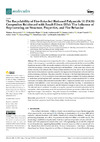Identificador persistente para citar o vincular este elemento:
https://accedacris.ulpgc.es/jspui/handle/10553/132115
| Campo DC | Valor | idioma |
|---|---|---|
| dc.contributor.author | Barczewski, Mateusz | en_US |
| dc.contributor.author | Hejna, Aleksander | en_US |
| dc.contributor.author | Andrzejewski, Jacek | en_US |
| dc.contributor.author | Aniśko, Joanna | en_US |
| dc.contributor.author | Piasecki, Adam | en_US |
| dc.contributor.author | Mróz, Adrian | en_US |
| dc.contributor.author | Ortega Medina, Zaida Cristina | en_US |
| dc.contributor.author | Rutkowska, Daria | en_US |
| dc.contributor.author | Sałasińska, Kamila | en_US |
| dc.date.accessioned | 2024-07-12T12:19:38Z | - |
| dc.date.available | 2024-07-12T12:19:38Z | - |
| dc.date.issued | 2024 | en_US |
| dc.identifier.issn | 1420-3049 | en_US |
| dc.identifier.uri | https://accedacris.ulpgc.es/handle/10553/132115 | - |
| dc.description.abstract | The growing requirements regarding the safety of using polymers and their composites are related to the emergence of more effective, sustainable, and hazardous-limited fire retardants (FRs). Significant amounts of FRs are usually required to effectively affect a polymer’s burning behavior, while the knowledge of their recycling potential is still insufficient. At the same time, concerns are related not only to the reduced effectiveness of flame retardancy but also, above all, to the potential deterioration of mechanical properties caused by the degradation of temperature-affected additives under processing conditions. This study describes the impact of the four-time reprocessing of bio-based polyamide 11 (PA11) modified with an intumescent flame-retardant (IFR) system composed of ammonium polyphosphate (APP), melamine cyanurate (MC), and pentaerythritol (PER) and its composites containing additional short basalt fibers (BFs). Composites manufactured via twin-screw extrusion were subjected to four reprocessing cycles using injection molding. A comprehensive analysis of their structural, mechanical, and fire behavior changes in each cycle was conducted. The obtained results confirmed the safety of using the proposed fire-retarded polyamide and its composites while reprocessing under the recommended process parameters without the risk of significant changes in the structure. The partial increase in flammability of reprocessed PA-based materials caused mainly by polymer degradation has been described. | en_US |
| dc.language | eng | en_US |
| dc.relation.ispartof | Molecules | en_US |
| dc.source | Molecules [ISSN 1420-3049], v. 29(13), 323 | en_US |
| dc.subject | 3303 ingeniería y tecnología químicas | en_US |
| dc.subject | 330804 Ingeniería de la contaminación | en_US |
| dc.subject.other | Polyamide | en_US |
| dc.subject.other | PA11 | en_US |
| dc.subject.other | Polyamide | en_US |
| dc.subject.other | Mechanical recycling | en_US |
| dc.subject.other | Waste management | en_US |
| dc.subject.other | Intumescent flame retardant | en_US |
| dc.subject.other | Composite | en_US |
| dc.subject.other | Basalt fibers | en_US |
| dc.subject.other | Flammability | en_US |
| dc.subject.other | Circular economy | en_US |
| dc.title | The Recyclability of Fire-Retarded Biobased Polyamide 11 (PA11) Composites Reinforced with Basalt Fibers (BFs): The Influence of Reprocessing on Structure, Properties, and Fire Behavior | en_US |
| dc.type | info:eu-repo/semantics/article | en_US |
| dc.type | Article | en_US |
| dc.identifier.doi | 10.3390/molecules29133233 | en_US |
| dc.identifier.issue | 13 | - |
| dc.investigacion | Ingeniería y Arquitectura | en_US |
| dc.type2 | Artículo | en_US |
| dc.utils.revision | Sí | en_US |
| dc.identifier.ulpgc | Sí | en_US |
| dc.contributor.buulpgc | BU-ING | en_US |
| dc.description.sjr | 0,744 | |
| dc.description.jcr | 4,2 | |
| dc.description.sjrq | Q1 | |
| dc.description.jcrq | Q2 | |
| dc.description.scie | SCIE | |
| dc.description.miaricds | 10,9 | |
| item.fulltext | Con texto completo | - |
| item.grantfulltext | open | - |
| crisitem.author.dept | GIR Fabricación integrada y avanzada | - |
| crisitem.author.dept | Departamento de Ingeniería de Procesos | - |
| crisitem.author.orcid | 0000-0002-7112-1067 | - |
| crisitem.author.parentorg | Departamento de Ingeniería Mecánica | - |
| crisitem.author.fullName | Ortega Medina, Zaida Cristina | - |
| Colección: | Artículos | |
Citas de WEB OF SCIENCETM
Citations
5
actualizado el 08-jun-2025
Google ScholarTM
Verifica
Altmetric
Comparte
Exporta metadatos
Los elementos en ULPGC accedaCRIS están protegidos por derechos de autor con todos los derechos reservados, a menos que se indique lo contrario.
